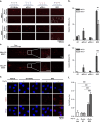Dendrimer Conjugates with PD-L1-Binding Peptides Enhance In Vivo Antitumor Immune Response
- PMID: 40244214
- PMCID: PMC12333478
- DOI: 10.1002/adhm.202500551
Dendrimer Conjugates with PD-L1-Binding Peptides Enhance In Vivo Antitumor Immune Response
Abstract
Peptides are an emerging class of biologics for cancer immunotherapy; however, their clinical translation is hindered by poor binding kinetics, bioavailability, and short plasma half-life compared to their corresponding antibodies. Nanoparticles present potential solutions but face scale-up difficulties due to complexity. Here, a translatable, modular nanoparticle scaffold is presented for peptide-based immune checkpoint inhibitors (ICIs). This platform is based on a simple structure of generation 7 (G7) poly(amidoamine) (PAMAM) dendrimers conjugated with engineered peptides (dendrimer-peptide conjugates, DPCs). DPCs functionalized with multiple copies of a programmed death-ligand 1 (PD-L1)-binding peptide exhibited significantly enhanced avidity-based binding kinetics and in vitro specificity, in addition to the substantially prolonged plasma half-life in vivo. Notably, a series of in vivo experiments revealed that DPCs displayed selective tumor accumulation and high efficacy, without apparent toxicity, when applied to a syngeneic mouse model bearing mouse oral carcinoma (MOC1) tumors. The results indicate that the DPC platform significantly improves the antagonistic effect and in vivo behaviors of the PD-L1-binding peptides, which can be potentially applied to virtually any peptide-based ICIs. The DPC platform's simplicity and modular nature will likely increase the potential of its clinical translation and ultimately enable precision/personalized cancer immunotherapy.
Keywords: Cancer immunotherapy; PD‐L1‐ binding peptide; dendrimer; immune checkpoint inhibitor; multivalent biding.
© 2025 The Author(s). Advanced Healthcare Materials published by Wiley‐VCH GmbH.
Conflict of interest statement
The authors declare no conflict of interest.
Figures







Similar articles
-
Oncolytic reovirus enhances the effect of CEA immunotherapy when combined with PD1-PDL1 inhibitor in a colorectal cancer model.Immunotherapy. 2025 Apr;17(6):425-435. doi: 10.1080/1750743X.2025.2501926. Epub 2025 May 12. Immunotherapy. 2025. PMID: 40353308
-
Development of a peptide-based tumor-activated checkpoint inhibitor for cancer immunotherapy.Acta Biomater. 2025 Jan 24;193:484-497. doi: 10.1016/j.actbio.2024.12.051. Epub 2024 Dec 22. Acta Biomater. 2025. PMID: 39716541
-
Avidity-Based Capture of PD-L1-Expressing Exosomes via Dendrimer-Peptide Conjugates: A Nanoengineered Platform for Enhanced Prediction of Immunotherapy Response.Adv Sci (Weinh). 2025 Aug 21:e09270. doi: 10.1002/advs.202509270. Online ahead of print. Adv Sci (Weinh). 2025. PMID: 40841859
-
Systemic treatments for metastatic cutaneous melanoma.Cochrane Database Syst Rev. 2018 Feb 6;2(2):CD011123. doi: 10.1002/14651858.CD011123.pub2. Cochrane Database Syst Rev. 2018. PMID: 29405038 Free PMC article.
-
Expression of Programmed Cell Death Ligand 1 as a Predictive Biomarker in Metastatic Urothelial Carcinoma Patients Treated with First-line Immune Checkpoint Inhibitors Versus Chemotherapy: A Systematic Review and Meta-analysis.Eur Urol Focus. 2022 Jan;8(1):152-159. doi: 10.1016/j.euf.2021.01.003. Epub 2021 Jan 27. Eur Urol Focus. 2022. PMID: 33516645
References
MeSH terms
Substances
Grants and funding
LinkOut - more resources
Full Text Sources
Research Materials

